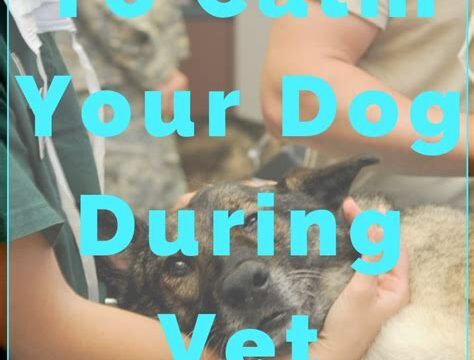Understanding Your Dog’s Anxiety
Many dog owners are familiar with the signs of anxiety in their furry friends. Whether it’s excessive barking, destructive behavior, or constant pacing, anxiety can greatly impact a dog’s overall well-being. As responsible pet owners, it is crucial to understand the root causes of their anxiety and find ways to alleviate their distress. By gaining a deeper understanding of your dog’s anxiety, you can provide the necessary support and create a comfortable environment for your beloved pet.
Anxiety in dogs can be triggered by various factors, such as separation, loud noises, unfamiliar environments, or past traumatic experiences. This emotional state can manifest in different ways, including restlessness, panting, trembling, or even aggression. It’s vital to identify these signs to help your dog cope with their anxiety effectively.
Here are a few key points to consider when understanding your dog’s anxiety:
1. Identifying Triggers: Take note of specific situations or events that seem to cause anxiety in your dog. By identifying these triggers, you can proactively avoid or manage them, minimizing your dog’s stress levels.
2. Body Language: Pay close attention to your dog’s body language. Raised hackles, pinned back ears, or a tucked tail are all indications that your furry friend may be feeling anxious or fearful. By recognizing these cues, you can offer reassurance and comfort when needed.
| Common Signs of Dog Anxiety: |
|---|
| Excessive barking or howling |
| Pacing or constant movement |
| Excessive panting or drooling |
| Trying to escape or hide |
| Destroying furniture or belongings |
3. Gradual Exposure: When faced with anxiety-inducing situations, it can be helpful to gradually expose your dog to them in a controlled manner. This process, known as desensitization, helps build their tolerance and confidence over time.
4. Positive Reinforcement: Reward your dog with praise, treats, or playtime when they display calm behavior. This positive reinforcement helps them associate positive experiences with situations that previously triggered anxiety.
5. Seek Professional Help: If your dog’s anxiety persists or severely affects their quality of life, it is essential to consult a professional, such as a veterinarian or certified dog behaviorist. They can provide expert guidance and recommend tailored strategies to address your dog’s specific anxieties.
Understanding your dog’s anxiety is a crucial step towards providing them with the support and care they need. By being attentive to their triggers, body language, and employing positive reinforcement, you can create a safe and secure environment that helps alleviate their anxiety. Remember, patience, consistency, and love are key when it comes to helping your furry friend overcome their fears.
Preparation Tips for a Calm Vet Visit
Visiting the veterinarian can be a source of anxiety and stress for both dogs and their owners. However, with proper preparation and planning, you can help create a calm and positive experience for your furry friend. By following these tips, you can make your next vet visit a less stressful one.
1. Plan Ahead:
Start by scheduling your vet appointment at a time when both you and your dog are relaxed. Avoid rushing or scheduling other activities immediately before or after the visit to minimize stress.
2. Familiarize Your Dog with the Vet:
Before the actual visit, take your dog to the vet’s office for a brief introduction. Let them get accustomed to the environment, sounds, and smells. This familiarity can help reduce anxiety during the actual appointment.
3. Use Positive Reinforcement:
Associate positive experiences with the vet by offering treats, praise, and rewards during the visit. This can help your dog develop a positive association with the vet and make subsequent visits less stressful.
4. Practice Handling:
Regularly handle and examine your dog at home, mimicking the actions the vet might take during a check-up. This can help desensitize your dog to being touched or inspected, making the actual vet examination less overwhelming.
5. Bring Comfort Items:
Bring your dog’s favorite blanket, toy, or treats to the vet’s office. These familiar items can provide reassurance and comfort during the visit, making it a more positive experience for your furry friend.
6. Stay Calm and Positive:
Dogs are highly attuned to their owner’s emotions, so it’s important to remain calm and composed during the vet visit. Your reassuring presence and positive demeanor can help reduce your dog’s anxiety and make the experience more pleasant for both of you.
Conclusion:
By implementing these preparation tips, you can help alleviate your dog’s anxiety and make vet visits less stressful. Remember, creating a positive association with the vet, practicing handling at home, and providing comfort can go a long way in ensuring a calm and positive vet visit for your beloved furry companion.
Creating a Positive Association with the Vet
When it comes to our furry friends, a trip to the vet can often be an anxiety-inducing experience. Whether it’s the strange smells, unfamiliar faces, or the discomfort of medical procedures, many dogs become fearful and anxious during vet visits. However, creating a positive association with the vet can go a long way in easing their anxiety and making the experience less stressful. In this blog post, we will explore some effective strategies to help your dog feel more comfortable and confident at the vet’s office.
One of the first steps in creating a positive association with the vet is to start early and introduce your dog to the vet’s office gradually. Instead of waiting until your dog is sick or in need of medical attention, consider scheduling a few “practice visits” to the vet when your dog is healthy. These visits can be short, non-invasive, and focused on positive experiences such as treats, praise, and playtime. By doing so, your dog will begin to associate the vet’s office with positive experiences and not just discomfort or fear.
Another effective technique is to use positive reinforcement during vet visits. Bring along some of your dog’s favorite treats or toys and reward them for calm and cooperative behavior. This will not only distract them from any discomfort or anxiety but also reinforce the idea that good things happen at the vet. It’s important to stay calm and composed yourself during the visit, as dogs are highly sensitive to their owner’s emotions. Your positive energy and reassurance can work wonders in alleviating your dog’s anxiety.
Calming Techniques for Anxious Dogs
Having an anxious dog can be a challenging experience for both the dog and their owner. Dogs can experience anxiety due to various reasons such as separation anxiety, fear of certain situations or triggers, or even past traumatic experiences. As responsible pet owners, it is our duty to help our furry friends feel calm and safe. In this blog post, we will discuss some effective calming techniques that can help alleviate anxiety in dogs.
1. Deep Pressure Therapy: Deep pressure therapy is a technique that involves applying gentle pressure to your dog’s body. This can be done by using a calming wrap or a tight-fitting garment. The pressure helps to release endorphins, which are natural hormones that promote relaxation and reduce anxiety. Additionally, deep pressure therapy mimics the feeling of being hugged or swaddled, providing a sense of security to your anxious dog.
2. Calming Music and Sounds: Just like humans, dogs can find solace in soothing music and sounds. Playing calming music or nature sounds in the background can help create a peaceful environment for your dog. There are several specially curated playlists and albums designed to reduce anxiety in dogs. These calming sounds can drown out loud noises that may trigger anxiety and promote a sense of tranquility.
3. Aromatherapy: Aromatherapy involves using essential oils to create a calming effect on dogs. However, it is crucial to remember that not all essential oils are safe for dogs. Lavender and chamomile are two examples of essential oils that are generally regarded as safe for dogs and are known for their relaxing properties. When using essential oils, it is essential to dilute them properly and consult with a veterinarian to ensure they are safe for your dog.
4. Massage and Tactile Stimulation: Just like humans, dogs can benefit from the power of touch. Massage and tactile stimulation can help relax your anxious dog’s muscles and promote a sense of calmness. Gently massaging your dog’s body with long, sweeping strokes can help release tension and reduce anxiety. Additionally, you can try offering your dog a gentle belly rub or ear massage, focusing on areas they enjoy being touched.
In conclusion, every dog is unique, and what works for one may not work for another. It is essential to be patient and understanding while exploring different calming techniques for your anxious dog. Remember to consult with a veterinarian or a professional dog trainer if your dog’s anxiety persists or worsens. With consistent efforts and a loving approach, you can help your furry friend find peace and alleviate their anxiety.
Choosing a Calming Environment
Creating a calming environment for your dog is crucial to help alleviate anxiety and stress. Dogs, just like humans, can feel overwhelmed in certain situations or environments, which can lead to behavior problems and psychological stress. By understanding what factors contribute to a calming environment, you can ensure your dog feels safe and comfortable, promoting their overall well-being.
One important aspect of a calming environment is reducing any potential triggers or stressors. Identify the things that tend to make your dog anxious or fearful, whether it’s loud noises, certain people, or specific objects. Avoid exposing your dog to these triggers whenever possible to create a more peaceful environment.
Another crucial element is providing a designated safe space for your dog. This can be a separate room or even a crate, where your dog can retreat to whenever they need a break or want to relax. Make this area comfortable and inviting by adding soft bedding, toys, and familiar scents. Ensure it is quiet and away from any disturbances.
- Remove any clutter or excessive stimuli from the environment.
- Keep the space well-ventilated and at a comfortable temperature.
- Consider using calming products such as pheromone diffusers or music specifically designed for relaxation.
Additionally, maintaining a consistent routine plays a significant role in creating a calming environment for your dog. Dogs thrive on predictability, so establishing a regular schedule for meals, exercise, and playtime can help reduce anxiety. Stick to the same feeding and walking times, as well as ensuring your dog has plenty of mental and physical stimulation throughout the day.
| Benefits of a Calming Environment |
|---|
| Reduces anxiety and stress levels in your dog |
| Promotes better behavior and reduces the likelihood of aggression or destructive actions |
| Enhances overall well-being and happiness |
| Helps in building trust and strengthening the bond between you and your dog |
In conclusion, choosing a calming environment is essential for the overall happiness and well-being of your dog. By minimizing triggers, providing a safe space, and maintaining a consistent routine, you can help alleviate anxiety and stress. Remember, each dog is unique, so it may take some trial and error to find the perfect calming environment for your furry friend. It’s a worthwhile effort to ensure your dog feels secure and at peace in their surroundings.
The Importance of Consistency and Routine
Consistency and routine are vital to maintaining stability and overall well-being, not just for humans but also for our beloved pets. Dogs, in particular, thrive on predictability and find comfort in knowing what to expect. Establishing a consistent routine can help relieve anxiety, promote good behavior, and strengthen the bond between you and your canine companion.
One of the main advantages of establishing consistency is that it allows your dog to feel secure and confident. Dogs are creatures of habit, and when their daily routines are disrupted, it can lead to stress and anxiety. By establishing a consistent schedule for feeding, exercise, and sleep, you can provide your dog with a stable and structured environment, which can help reduce anxiety and promote a sense of well-being.
A routine also plays a crucial role in behavior management. When a dog knows what is expected of them and what to anticipate, it becomes easier for them to follow commands and exhibit desirable behavior. By consistently reinforcing rules and expectations, you can effectively communicate with your dog and establish boundaries. This not only helps in preventing unwanted behaviors but also allows your dog to feel more comfortable and less anxious in their surroundings.
In addition to providing a sense of stability and promoting good behavior, consistency and routine can also strengthen the bond between you and your furry friend. When your dog knows what to expect from you and feels secure in their daily routines, they will develop a greater sense of trust and dependency on you as their caregiver. This bond can be further enhanced through daily activities such as regular walks, playtime, and grooming sessions, which not only provide physical exercise but also create opportunities for positive interactions and emotional connection.
In conclusion, consistency and routine are essential for the overall well-being of your furry friend. By establishing a consistent schedule and sticking to it, you can help alleviate anxiety, promote good behavior, and strengthen the bond between you and your dog. Remember, it’s not just about the physical needs of your pet but also their emotional and mental well-being, and providing them with a stable and structured environment is key to ensuring their happiness and contentment.
Seeking Professional Help for Severe Anxiety
Dealing with a dog who has severe anxiety can be incredibly challenging and can significantly impact both their quality of life and yours. While there are various techniques and strategies that can help manage mild to moderate anxiety in dogs, sometimes professional help is necessary to address severe anxiety. In this blog post, we will explore the importance of seeking professional help, what to expect from a professional, and the different options available to help your furry friend overcome their severe anxiety.
Why Seek Professional Help?
When your dog’s anxiety reaches a severe level, it can have a profound impact on their overall well-being. Just like humans, dogs can experience debilitating anxiety that affects their ability to function and enjoy life. Seeking professional help is crucial because trained professionals have the knowledge and expertise to accurately diagnose the severity of your dog’s anxiety and develop an individualized treatment plan.
What to Expect From a Professional
When you decide to seek professional help for your dog’s severe anxiety, you will likely work with a veterinary behaviorist, a licensed veterinarian with specialized training in behavioral medicine. The behaviorist will conduct a thorough assessment to understand the underlying causes of your dog’s anxiety. This assessment may involve observing your dog’s behavior, taking a detailed history, and possibly conducting laboratory tests to rule out any underlying medical conditions that could be contributing to their anxiety.
Treatment Options for Severe Anxiety
After diagnosing your dog’s severe anxiety, the veterinary behaviorist will develop a tailored treatment plan to address their specific needs. This plan may involve a combination of therapies, including medication, behavior modification, and environmental changes. Medications used to treat severe anxiety in dogs may include anti-anxiety drugs or antidepressants, but their use should be carefully monitored by a professional to ensure effectiveness and minimize potential side effects.
| Pros of Seeking Professional Help | Cons of Seeking Professional Help |
|---|---|
| Accurate diagnosis of the severity and causes of your dog’s anxiety. | Cost of professional consultations and treatments. |
| Access to specialized knowledge and expertise in behavioral medicine. | Potential need for ongoing therapy and long-term treatment. |
| Customized treatment plans tailored to your dog’s specific needs. | Possible side effects from medication. |
While seeking professional help for your dog’s severe anxiety may come with some cons, the benefits far outweigh any drawbacks. Remember, your dog’s well-being and happiness are the ultimate priority, and with the guidance of a professional, you can help them overcome their anxiety and live a more fulfilling life.
Frequently Asked Questions
Q1: How can I understand if my dog is experiencing anxiety?
A1: Dogs may exhibit signs of anxiety such as excessive barking, panting, pacing, and restlessness. They may also show avoidance behaviors, trembling, and decreased appetite. It’s important to observe your dog’s behavior and consult with a veterinarian if you suspect anxiety.
Q2: What can I do to prepare my anxious dog for a calm vet visit?
A2: To prepare your anxious dog for a vet visit, you can desensitize them to the vet office by gradually introducing them to the environment. Use positive reinforcement and rewards to create a positive association with the vet. Additionally, practicing handling exercises at home can help reduce stress during the visit.
Q3: How can I create a positive association between my dog and the vet?
A3: Creating a positive association with the vet involves using rewards like treats or toys during and after vet visits. Building a positive relationship with the veterinarian and the staff can also help your dog feel more comfortable. Remember to praise and reward your dog for calm behavior during the visit.
Q4: What are some calming techniques I can use for my anxious dog?
A4: Calming techniques for anxious dogs include using gentle touch or massage, playing calming music, using aromatherapy with relaxing scents, and using anxiety wraps or vests. Consult with a professional trainer or behaviorist to learn specific techniques that may work best for your dog.
Q5: How do I choose a calming environment for my anxious dog?
A5: When choosing a calming environment for your anxious dog, consider a quiet, safe, and familiar space where your dog can relax. Create a cozy space with comfortable bedding, toys, and a diffuser with calming pheromones. Minimize loud noises, bright lights, and other stimuli that may trigger anxiety.
Q6: Why is consistency and routine important for an anxious dog?
A6: Consistency and routine are crucial for anxious dogs as they provide a sense of security and predictability. Establishing a regular feeding, exercise, and sleep schedule can help reduce anxiety. Consistent training methods and boundaries also help anxious dogs understand what is expected of them, leading to a calmer demeanor.
Q7: When should I seek professional help for my dog’s severe anxiety?
A7: If your dog’s anxiety is severely impacting their quality of life or causing harmful behaviors, it’s important to seek professional help from a veterinarian, certified dog trainer, or animal behaviorist. They can provide a thorough evaluation, recommend behavior modification techniques, and, if necessary, prescribe medication to help manage your dog’s anxiety.





